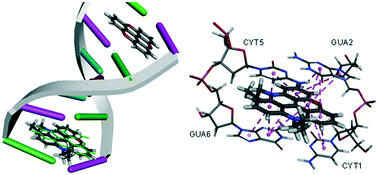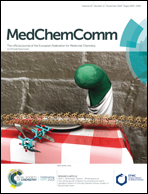The cytotoxic potential of cationic triangulenes against tumour cells†
Abstract
TOTA (trioxatriangulenium ion) is a close-shelled carbocation known to intercalate strongly with the DNA double helix (J. Reynisson, G. B. Schuster, S. B. Howerton, L. D. Williams, R. N. Barnett, C. L. Cleveland, U. Landman, N. Harrit, J. B. Chaires, J. Am. Chem. Soc. 2003, 125, 2072). The cytotoxicity of TOTA and its four close structural analogues, ADOTA, Pr-ADOTA, Pr-DAOTA and n-Butyl-TATA were tested against the breast cancer cell line MDA-MB-231 and colon cancer cell line HCT116. The most potent derivatives Pr-ADOTA and Pr-DAOTA had IC50 values of ∼80 nM for MDA-MB-231 but slightly higher for HCT116 in the low hundreds nM range. A 3D model assay of HCT116 spheroids was also used, mimicking a tumour environment, again both Pr-ADOTA and Pr-DAOTA were very active with IC50 values of 38 nM and 21 nM, respectively. Molecular modelling suggest that the planar derivatives intercalate between the base pairs of the DNA double helix. However, only modest DNA double stranded DNA cleavage was observed using the γH2AX assay as compared to camptothecin, a topoisomerase I poison suggesting a different mechanism. Finally, a robust density functional theory (DFT) model was built to predict the pKR+ stability values, i.e., to design derivatives, which predominantly have a non-intercalating buckled form in healthy tissues followed by a nucleophilic attach of water on the central carbon, but a planar form at relatively low pH values rendering them only cytotoxic in the interior of tumours.



 Please wait while we load your content...
Please wait while we load your content...